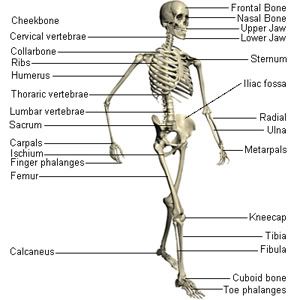
The diagram I chose for this assignment was a diagram of the human skeleton. This diagram clearly labels particular bones, a very critical part of diagrams. The purpose of this diagram is to familiarize a person with the skeletal structure. It could be pointed at an audience of high school or college students in an anatomy class, or it could be for a web-site for science or medicine. I think that diagrams, especially on the Internet or in some digitalized format, are a great help to web users because they offer a visual piece of information, rather than a lot of text on a screen. Some diagrams are interactive, allowing you to scroll over certain areas of it and uncover more information about the content of that diagram. This diagram is a great learning tool because it tells you where many bones are on the body. I have personally learned from something similar to this in my anatomy class in high school. It is a lot easier to learn off a diagram rather than reading about it in a book (in this case anyways). The diagram you see came from here, explaining 3D software that allows you to fully experience the skeletal system. The problem with removing it from its original site is that now it is purely 2D material; no one would think that this would be a view from a 3D program. Given that, it is important to note where a person gets a diagram, or any information, off of a web site. I already have a link to that web site previously posted in this paragraph.
The details labeled in this diagram are the bones of the skeleton. I would not have changed any labels on this, except if the diagram was larger, I would have added more labels, as there are 206 bones. So, what does this have to do with writing? Diagrams make writing come alive. In a sense, they are a billboard for the pen and paper.
1 comment:
After reading Josh's blod entry about diagrams, I agreed with everything he says. His last line says it all, "Diagrams make writing come alive." that is the perfect statement to describe these illustrations and drawings because a diagram can provide information that text cannot. Some things or aspects can only be learned visually. In this case, learning parts of the human skeleton is a lot easier to learn, comprehend, and understand when you have a visual model to analyze. It is helpful because it pin-points exactly where each bone is located. Josh explains that the labels are very important, which I completely agree, especially in a diagram that is meant to be for educational learning purposes. After observing his diagram and post, it reminded me a great deal of mine. My diagram was also medically related, as I chose to use the human brain that also had labels on it and pointed to each area. Furthermore, I noticed how Josh explained that labeling and identifying every single bone was not necessary, for if everyone had been labeled, the diagram would be too confusing. I also had the same reasoning in my picture of the brain, for if there is too much information or data, the diagram can be too complex and too hard to understand. Diagrams can be very helpful and very useful is they are accurate and easy to understand, and the picture Josh chose and wrote about was a perfect example.
Post a Comment